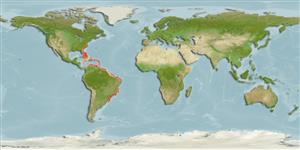Actinopterygii (ray-finned fishes) >
Anguilliformes (Eels and morays) >
Ophichthidae (Snake eels) > Ophichthinae
Etymology: Apterichtus: From the Greek ??????? (apteron), without fins, and ????? (ichtus, more correctly written ichthys;
masculine), fish..
Environment / Climate / Range
Ecology
Marine; demersal; depth range 1 - 38 m (Ref. 101270). Subtropical, preferred ?; 37°N - 33°S, 81°W - 33°W
Western Atlantic: USA (from the Carolinas and southern Florida Keys), Bermuda, Bahamas, Lesser Antilles, and off Brazil.
Size / Weight / Age
Maturity: Lm ? range ? - ? cm
Max length : 54.0 cm TL male/unsexed; (Ref. 7251)
Short description
Morphology | Morphometrics
Vertebrae: 123 - 132. This elongate species is distinguished by the following characters: tail 1.7-1.8, head 12-15, and body depth 43-53 in total length; preopercular pores 4 and pores in supratemporal canal 5; teeth conical, uniserial on jaws and vomer; vomerine teeth 3-4 ; body coloration is nearly uniform pale to tan, fresh specimens have a fine sprinkling of melanophores over the dorsal surface of the head and body, with pale areas behind eye and along lower jaw; MVF 54-128, total vertebrae 123-132 (Ref. 101270).
Burrows in sand in surf areas.
Life cycle and mating behavior
Maturity | Reproduction | Spawning | Eggs | Fecundity | Larvae
Distinct pairing (Ref. 205).
McCosker, J.E. and Y. Hibino, 2015. A review of the finless snake eels of the genus Apterichtus (Anguilliformes: Ophichthidae), with the description of five new species. Zootaxa 3941(1):49-78. (Ref. 101270)
IUCN Red List Status (Ref. 115185)
CITES (Ref. 94142)
Not Evaluated
Threat to humans
Harmless
Human uses
More information
Age/SizeGrowthLength-weightLength-lengthLength-frequenciesMorphometricsMorphologyLarvaeLarval dynamicsRecruitmentAbundance
ReferencesAquacultureAquaculture profileStrainsGeneticsAllele frequenciesHeritabilityDiseasesProcessingMass conversion
Tools
Special reports
Download XML
Internet sources
